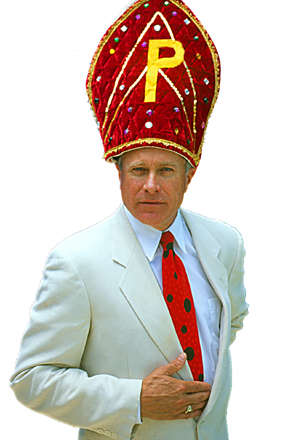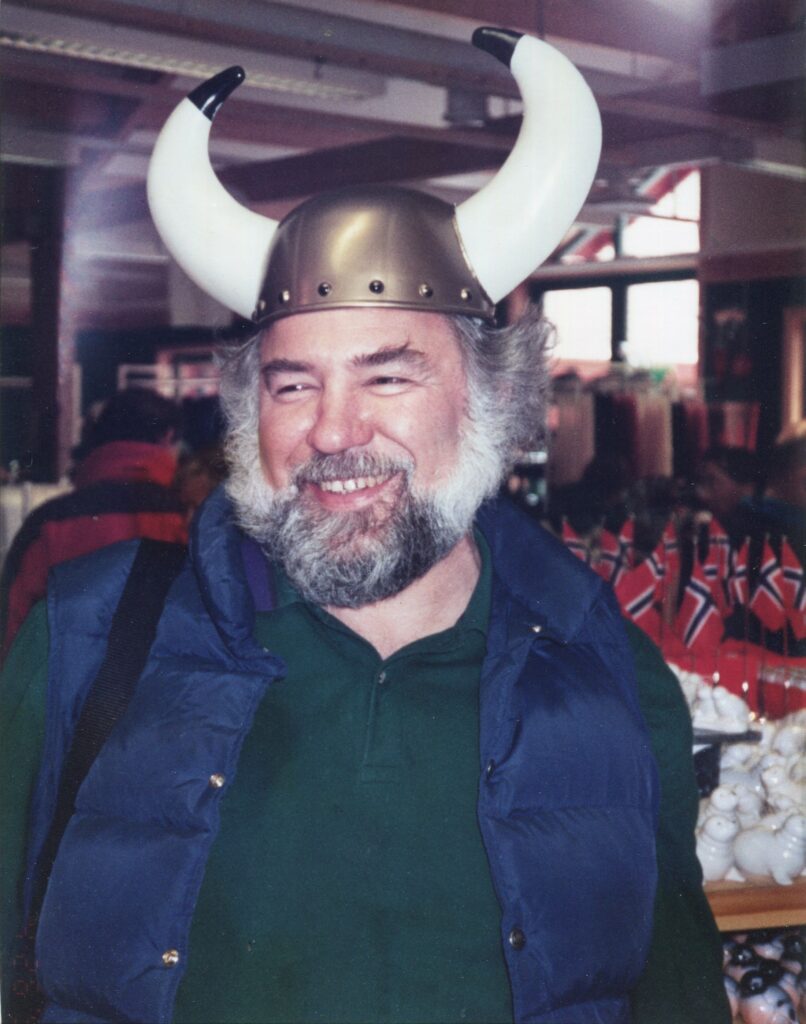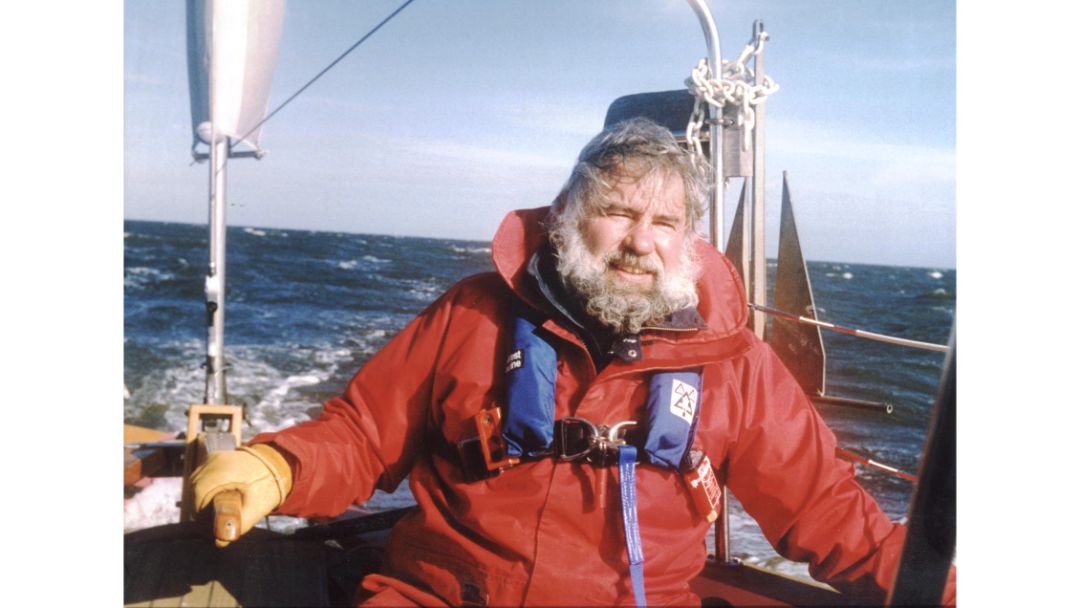
Carl Ettlinger at the helm of Excalibrater
One of the many hats I wore as North American binding product manager for Salomon in the early 1980’s was that of delegate to the American Society for Testing and Materials (ASTM). I believe the first meeting of F8.14 – the sub-committee on ski safety – that I attended was in Pennsylvania. I was flying under the wings of Salomon’s seer of all standards and patents, Gilbert Delouche, and the binding product manager for the North American zone at that time (and my mentor), Joe Campisi.
I was a babe in the woods, but I soon caught on to the game under Delouche’s patience guidance. I recall a debate on the binding specification then being batted around in the technical committee chaired by Carl Ettlinger. Ettlinger wanted language that would require any release/retention setting of 10 or above to be “visually distinctive” from the rest of the scale.
Ettlinger’s intent was to signal to consumers that settings above 10 were patently dangerous by changing their color to red. Delouche didn’t want a design limitation placed on how Salomon might industrialize its next series of bindings, never mind the philosophic objection (the French are born philosophers), that 10 was a meaningful safety boundary. I asked if he were going to object to Ettlinger’s proposed language. He paused before answering quietly, his eyes smiling, “You know, Jackson, the number 10 is already visually distinctive from 9.” Ah.
Within two years I was not only Salomon’s primary delegate to what became F-27, a full committee all to itself in the ASTM pantheon, but I was elected General Secretary of said main committee. I took the post both for its potential to influence certain desirable outcomes and because it gave me direct control of the written record.
This last point was critical, for outside our hallowed halls, the ski trade was a liability nightmare. Salomon alone was party to some 400+ lawsuits a year, in a way, by design. In 1977 Salomon had introduced the ski market to indemnity insurance when it offered its dealers free coverage against liability claims involving its bindings provided that the dealer observed some key requirements.
Salomon wanted all claims funneled its way so the brand could protect itself with the best litigators, rather than let dealers fend for themselves with whatever counsel was at hand. We never lost, but the costs were considerable and the whole arena begged for a re-set.
It was into these turbulent waters that Ettlinger, along with scientists and researchers in his orbit, was set to launch two new standards governing shop practices. In 1984, the proposed practices were dialed in and ready to vote into adoption. Passage would cap a decade-long battle by Ettlinger to require shops to inspect every ski/boot/binding system they sold or rented, including a series of function tests and an all-important calibration check.
This last point was a bone in the throat of most binding manufacturers. Their bindings all went through computer-monitored calibration verification when manufactured; the trinkets the shops would use to verify the accuracy of binding settings were Stone Age tools in comparison. Some eyed Ettlinger’s evangelism with suspicion as he made a torque wrench that shops could buy to fulfill the new standards’ requirements.
Pardon this digression, but I can’t mention this old bit of tarnish on Carl’s legacy without correcting the impression it leaves. Ettlinger did indeed profit when the standards went into effect, resulting in the one great indulgence of his life, his sailboat Excalibrator, named for the Vermont Calibrator that funded it. As near as anyone can tell, including close friends and family, every other cent Ettlinger ever made he plowed back into his research into ski injuries and how to best prevent them.

Averting Catastrophe
With the decisive vote on the shop standards looming on the calendar, I knew I had to act. The North American dealer community had no idea that standards were about to pass that would change certification and indemnification requirements. Overnight, they would be obliged to perform binding inspections they’d never done and had neither the equipment nor training to execute.
I needed to buy time in a process that looked to be out of it. I had become a student of ASTM by-laws and that’s where I turned for the solution. The by-laws wouldn’t allow manufacturers to stack a committee with their members by setting limits on how many voting members could come from any one sector. For shop practices, intended users of the standard were a separate constituency, so that’s where I recruited enough new members to effectively block the shop standards from passage this time around.
I used the two years my stratagem had effectively bought to publish the new standards as an accepted alternative practice to Salomon’s own protocols. I trained our field force in how to steer their dealers into safe waters. I used my position as the chair of SIA’s Skiing Safety Committee to facilitate the creation of point-of-sale messaging, sponsored by all binding brands, explaining the new practice to consumers. In 1987, the shop practices standards would pass, all suppliers adopted them as their only recommended procedures, dealers were ready to comply and, coincidentally, I would depart Salomon.
Epilog
Part of my first two years as a Salomon alumnus was spent as an instructor on the Skiing Mechanics and Managers Workshop Tour, where the star attraction was one Carl Ettlinger. No longer cast in adversarial roles, Ettlinger and I developed a truly delightful relationship.
We lost Carl Ettlinger earlier this year. Among those who knew him, his departure hit with the force of a shock wave; only in his absence did we realize the gargantuan void he left in his wake. I’ve posted my thoughts on his passing here, a surge of memories that his daughter Heidi was kind enough to read at his funeral service. For a fuller appreciation of Ettlinger’s prolific career, please read a short history here.
I don’t know how much the continent-wide adoption of Ettlinger’s cherished shop practices standards had to do with it, but by the mid-1990’s the tide of liability claims against retailers and renters turned to a trickle. I may have played a small part in that the liability waiver then in wide use was largely the creation of Ettlinger, myself and an attorney provided by the National Ski Areas Association named David Cleary. We hammered it out when holed up in some Boston office tower. Like Ettlinger, Cleary was a sparkling raconteur with a rapier wit. Drafting legalese in their company was actually, dare I say it, fun.
As for my primary objective in retarding the standard development process – preserving the North American dealer community – my feeble efforts couldn’t possibly save a market under assault from all sides. I’m sure every ski industry insider who has observed the last forty years can provide his/her own Top Ten list of Reasons Ski Sales Have Shrunk.
I’ll start working on my list. If any of my Dear Readers would care to send me theirs, I’ll compile them and post the lot on Realskiers.

